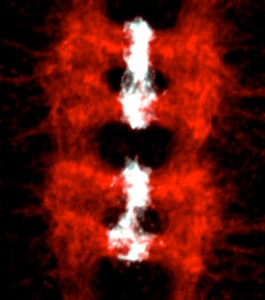Neuregulin and PDGF are gliatrophic factors during axon guidance

We have shown that the control of neuronal and glial cell survival is a more ancient mechanism than previously thought, conferring plasticity to nervous system development also in invertebrates. Glial cells are produced in excess during normal development and interactions between distinct cell populations – neurons and lglia – adjust each others numbers to enable appropriate nervous system formation and function. Two of the main gliatrophic factors in vertebrates are Neuregulin and PDGF. Drosophila glia number is regulated by the non-autonomous control of cell survival, using these conserved molecular pathways: (1) Targeted neuronal ablation results in an increase in glial apoptosis. The Drosophila Neuregulin homologue, called Vein, is produced by neurons and regulates the survival of a subset of longitudinal glia via the Ras/MAPKinase/ERK pathway. This was the first evidence of a conserved gliatrophic factor from vertebrates to flies (Hidalgo et al 2001 Developmental Cell). (2) The PVF/PVR signalling pathway regulates midline glial survival and migration in Drosophila, via the P13K/Akt pathway. This is likely to be redundant with the EGF pathway, which has been well documented by others to promote midline glia survival. The effects on cell number can be more subtle in fruit-flies compared to vertebrates, but this is the effect of scale, as the mechanisms are conserved and influence axon guidance.
Read more in:
Learte, Forero and Hidalgo (2008) Gliatrophic and gliatropic functions of PVR signalling during axon guidance. Glia 56, 164-176
Hidalgo, A., Kinrade, E. and Georgiou, M. (2001) The Drosophila neuregulin Vein maintains glial survival during axon guidance in the CNS. Developmental Cell 1, 679-690
Dedicated mini-reviews: Beck & Fainzibler (2002) Neuron 33, Leslie (2001) JCBiol 155
Funded by: MRC studentship, The Wellcome Trust, MRC CEG and EMBO YIP.